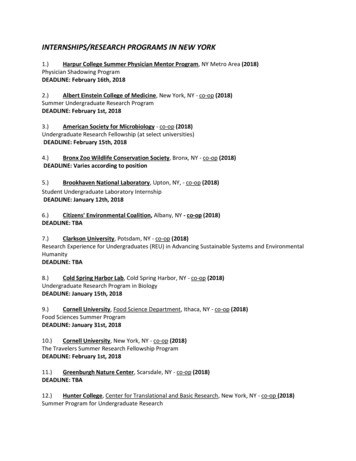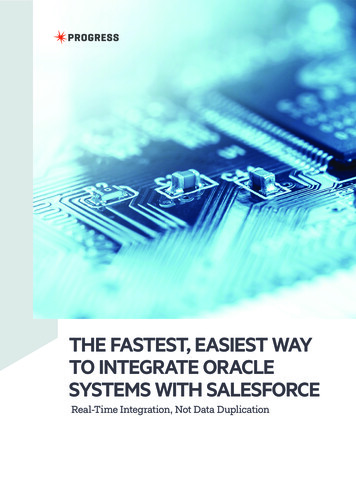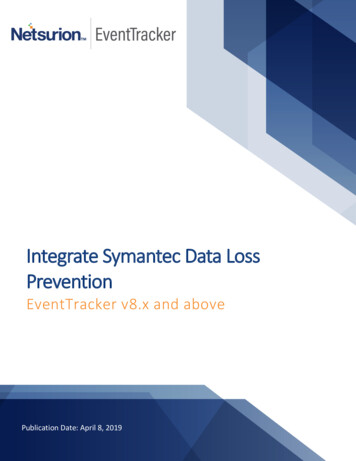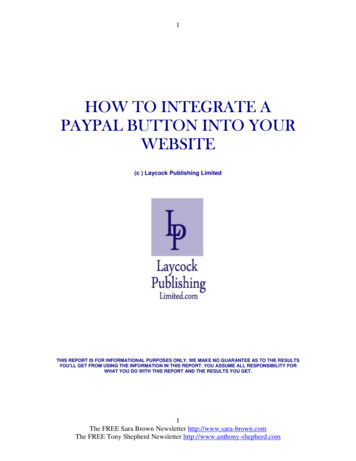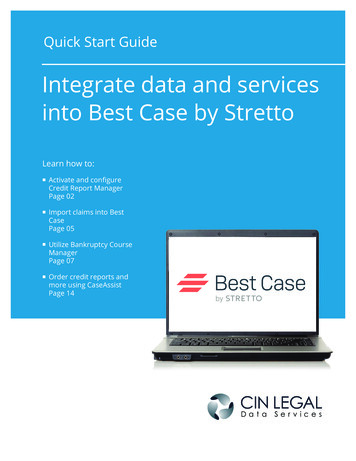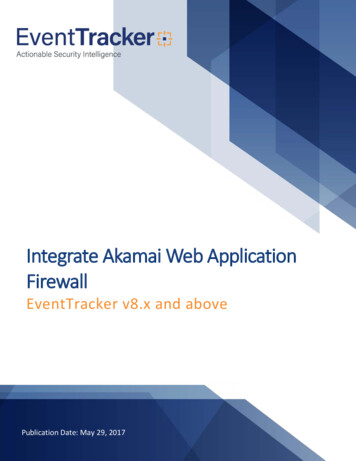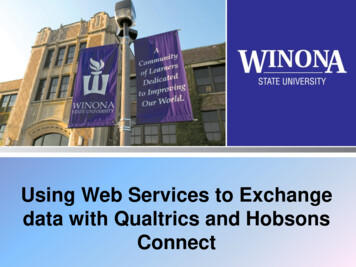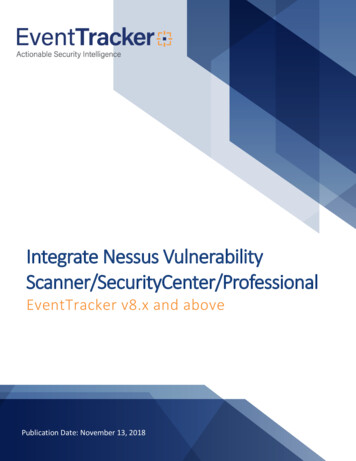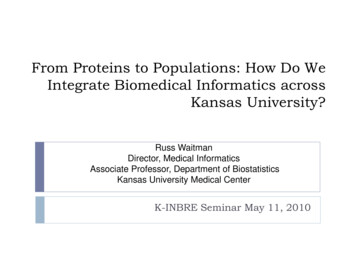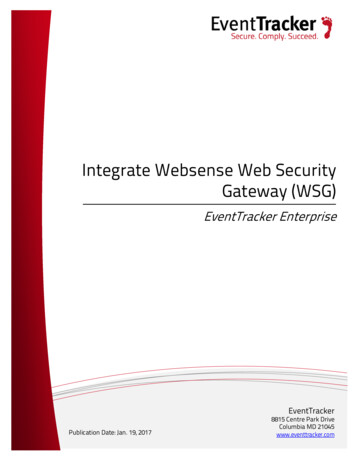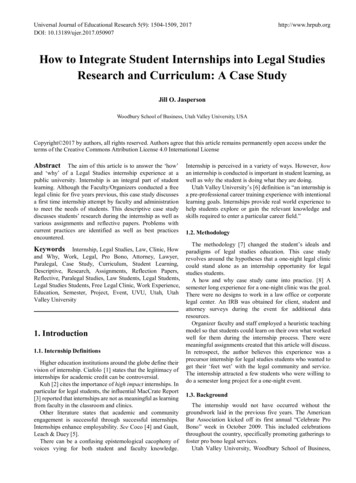
Transcription
Universal Journal of Educational Research 5(9): 1504-1509, 2017DOI: 10.13189/ujer.2017.050907http://www.hrpub.orgHow to Integrate Student Internships into Legal StudiesResearch and Curriculum: A Case StudyJill O. JaspersonWoodbury School of Business, Utah Valley University, USACopyright 2017 by authors, all rights reserved. Authors agree that this article remains permanently open access under theterms of the Creative Commons Attribution License 4.0 International LicenseAbstract The aim of this article is to answer the ‘how’and ‘why’ of a Legal Studies internship experience at apublic university. Internship is an integral part of studentlearning. Although the Faculty/Organizers conducted a freelegal clinic for five years previous, this case study discussesa first time internship attempt by faculty and administrationto meet the needs of students. This descriptive case studydiscusses students’ research during the internship as well asvarious assignments and reflective papers. Problems withcurrent practices are identified as well as best practicesencountered.KeywordsInternship, Legal Studies, Law, Clinic, Howand Why, Work, Legal, Pro Bono, Attorney, Lawyer,Paralegal, Case Study, Curriculum, Student Learning,Descriptive, Research, Assignments, Reflection Papers,Reflective, Paralegal Studies, Law Students, Legal Students,Legal Studies Students, Free Legal Clinic, Work Experience,Education, Semester, Project, Event, UVU, Utah, UtahValley University1. Introduction1.1. Internship DefinitionsHigher education institutions around the globe define theirvision of internship. Ciafolo [1] states that the legitimacy ofinternships for academic credit can be controversial.Kuh [2] cites the importance of high impact internships. Inparticular for legal students, the influential MacCrate Report[3] reported that internships are not as meaningful as learningfrom faculty in the classroom and clinics.Other literature states that academic and communityengagement is successful through successful internships.Internships enhance employability. See Coco [4] and Gault,Leach & Duey [5].There can be a confusing epistemological cacophony ofvoices vying for both student and faculty knowledge.Internship is perceived in a variety of ways. However, howan internship is conducted is important in student learning, aswell as why the student is doing what they are doing.Utah Valley University’s [6] definition is “an internship isa pre-professional career training experience with intentionallearning goals. Internships provide real world experience tohelp students explore or gain the relevant knowledge andskills required to enter a particular career field.”1.2. MethodologyThe methodology [7] changed the student’s ideals andparadigms of legal studies education. This case studyrevolves around the hypotheses that a one-night legal cliniccould stand alone as an internship opportunity for legalstudies students.A how and why case study came into practice. [8] Asemester long experience for a one-night clinic was the goal.There were no designs to work in a law office or corporatelegal center. An IRB was obtained for client, student andattorney surveys during the event for additional dataresources.Organizer faculty and staff employed a heuristic teachingmodel so that students could learn on their own what workedwell for them during the internship process. There weremeaningful assignments created that this article will discuss.In retrospect, the author believes this experience was aprecursor internship for legal studies students who wanted toget their ‘feet wet’ with the legal community and service.The internship attracted a few students who were willing todo a semester long project for a one-night event.1.3. BackgroundThe internship would not have occurred without thegroundwork laid in the previous five years. The AmericanBar Association kicked off its first annual “Celebrate ProBono” week in October 2009. This included celebrationsthroughout the country, specifically promoting gatherings tofoster pro bono legal services.Utah Valley University, Woodbury School of Business,
Universal Journal of Educational Research 5(9): 1504-1509, 2017and the Legal Studies Department joined in with a Free LegalClinic in October of that year. The event was a huge effort,consisting of twenty-plus attorneys and fifty-plus studentsparticipating and ready to render services. To the shock ofthe organizers, the public came out in huge numbers—overone hundred and fifty people, despite the cold weather.The effort expanded and became a staple for Legal Studiesstudents, UVU staff and faculty, and the surroundingcommunity in the following years: 2010, 2011, 2012, 2013and 2014. Touted as the Largest One-Night Free Legal Clinicin the country, attorney numbers rose at its peak to thirtyattorneys. These attorneys worked for three hours for justone evening solving problems for dozens seeking help, withno remuneration, accounting for legal service costs of 25,000 or more. The event expanded, and the footprint ofpro bono in the community became larger through the UVUFree Legal Night recognition.In 2013, Organizers applied to the university for seedmoney to help with the burgeoning interest in the one-nightclinic and received grant money to pay an administrativeassistant and for additional marketing materials.Organizers also realized the importance of sustainability,obtained IRB approval and surveyed students, attorneys, andclients with a five-minute survey to gauge continued success.The organizers faculty were elated with the survey results,and looked forward to 2014.Two thousand fourteen was a banner year for the FreeLegal Clinic. It was the sixth year for the clinic. It wascoming into its own, but further help was needed as numbersgrew.Organizers were able to use the same assistant withleftover monies to move the work forward. In past years,Faculty gave engaged learning points to students for helpingwith the Free Legal Clinic. Organizers decided it was timethat students should receive credit for participating and theFree Legal Clinic internship evolved.1.4. ProceduresFaculty obtained an email list of all students enrolled inthe legal studies program Freshman-Senior years. Allstudents were contacted the summer before Fall Semester2014 started. Faculty and staff had a large organizationalmeeting the second week of class. Students were recruited,and procedures explained how to sign up through theadministration for the internship, how the UVU Free LegalClinic was conducted, and why the event was being held.Student questions were addressed and eleven studentsbecame involved. Staff made immediate assignments asdiscussed below.1.5. Student Internship Curriculum: Activities &AssignmentsPast years had taught the Organizers that how to marketthe event was key to bringing in more clients. Half of the1505pre-event organization centered on contacting people. Theeleven internship students fell into five outreach areas:Community Outreach OneCommunity Outreach Two,Community Outreach Three,UVU and Classroom Outreach, andAttorney Outreach and Event DetailsCommunity Outreach One, Two and Three consisted ofmarketing duties. This was not something Legal Studiesstudents studied or had experience dealing with.Heuristically, the process of developing how to market was agood experience for the students, even though it was out oftheir comfort zone.Interns contacted courts, county and local governmentagencies, community centers, and schools. They contactedthese entities and inquired about poster and flyerrequirements. Inquiries led to return calls and posterplacements. How did the outreach students do? Here aresome of their thoughts:“I was so nervous to reach out to people to inform themabout the legal clinic. In order to conquer my fear ofspeaking to people I do not know, I wrote a script for myself.The lesson that was learned from the part in the pre-clinicpreparation was how to help my fear of calling others. Thisfear was aided by writing a ‘manuscript’ to help me throughthe phone call with the necessary information.”“I completed 30 hours of service [for pre-event], thisincluded putting up flyers, posters, ads on the Internet and oncampus and as well as the community. And translating flyers,posters, and papers.”“I tried the ACLU which I thought would be another goodoption to advertise with.”“I learned through talking with the people that would be incharge of placing the flyers out at all of these communityoutreach groups, that they were very excited to have at leastflyers, and most took a poster also. They took quite a fewflyers because they thought the clients they help throughtheir resources would also benefit.”Other Outreach methods incorporated social media sites,blogs, city and town websites, along with mayoral websitesto contact administrators for posting event information.Students unfolded further outreach and researched furtherideas for contact: they figured how to translate surveys andintake in Spanish. They also visited other outreach areas,which were not on the list. Here are some of the comments:“I had to translate a few documents from English toSpanish that challenged me and I had to really focus becauseI did [not] want to mess up, so I had to do the best of mywork.”“I also visited local senior homes and got positivefeedback from that. At one home I called, they asked me ifUVU would [be] interested in holding a seminar at theirhome for legal advice.”UVU and Classroom Outreach consisted of internscontacting the school of business classes. Interns encouragedprofessors, students and their families to come to the event.
1506How to Integrate Student Internships into Legal Studies Research and Curriculum: A Case StudyThis Outreach group also perfected the Pro Bono surveyspreviously used in antecedent years. Interns edited line byline, and reworked the format. Comments include:“One of my tasks that I was assigned were class visits. Inthe beginning, the class visits sounded intimidating, but Istuck to it. I loved going to different classes with people whowere also in the internship because it was reassuring. Afterthe first time, I felt confident and it wasn’t very difficult. Ithink that having students visit classes was one of the mostefficient ways of getting the word out.”Attorney Outreach and Event Details consisted of internsmaking reminder calls to attorney offices, makinginformation calls and emails to update attorney practice areas,finding Spanish speakers, taking photos of the event, alongwith doing client intake and registration during the event.Interns helped create and send out the Attorney Outreachletter.Examples of the attorney outreach:“Dear ,Thank you for volunteering your time for our legalconsultation clinic at UVU. It is only three weeks away!This signifies special support from you as we make stridesto fill the justice gap in County.We are excited that you will join us for this Sixth Annualevent:Sixth Annual ClinicDatePlace and Time for Attorney DinnerClients-(First Come, First Serve) meet in forintake. Consultations 7-9pm in assigned consult/studyrooms:You are assigned legal interns, assistants and/or lawstudents to observe you and timekeepers to keep track of the15-20 minute consultations. If you need anything donethroughout the evening, your assistants and timekeeper arethere to help. We also have runners to help clients find yourconsult room. Once you find your consultation room, pleaseremain there until the evening is over.We will have intake forms available for the clients, whichthey will fill out before they meet with you. After the night isover, make sure that your assistants (or you) return all theintake sheets with your notes to me or to the intake desk.Access to justice is the cornerstone of our democracy.Many individuals are unaware of what constitutes a legalproblem. Your help is especially important during thisinteresting economic time.Should you have further questions that I have failed tocover, please email or call at .Thank you again for your participation.”Many of these activities seem mundane and not related tolegal work. However, literature has shown that academicbenefits may be due to aspects of the non-academicenvironment in which the internship happens. See Binder [8].1.6. Student Research: Assignments and ActivitiesAdditional assignments covered the why of the internship.Each intern had to interview an attorney, a legal assistant,and go to court and report.Interview questions included ‘why’ questions that helpedinterns search deeper as to why they would want toparticipate in the legal profession.Some of these questions were:Why did attorney decide to attend law school?Why did attorney choose/want to go to a particular lawschool?Why did attorney choose the legal profession?Why did attorney choose to do pro bono work this year?Why do you do law?Why did legal assistant choose the legal profession?Why did legal assistant choose to do the specialized jobthey do?Why legal assistants cannot offer legal advice?Why do you do law?Why did the judge rule the way she/he did?Why is the judge so strict or confusing?Why are there court standards of dress?Why are there certain court protocols?Why is there a reading of rights in court?Why is there a jurisdiction issue?These ‘why’ questions also spurred other ‘why’ questions.Interns would have to research law school, curriculum, legalassistant curriculum, pro bono, court procedures, judgeships,jurisdiction, constitutional issues, et cetera on their own.Through the gnawing questions of how and why of the wholeinternship, interns had to research in all phases.1.7. Additional ResearchThere were additional documents that students had tocreate, including the legal clinic release form, and intakedocuments. A sample of these is also included:Release form:“With respect to any conversation I may have with anyattorney as part of this legal clinic, I understand, agree, andacknowledge by signing this agreement that:Most factual and legal issues are complex, and it ispossible that the attorney and I will each misunderstand whatthe other is trying to communicate;Although the attorney may take notes during ourconversation, the attorney will not keep such notes or otherwritten record of our conversation;I have no obligation to the attorney, and the attorney hasno continuing obligation to me unless I choose to retain theattorney for further services beyond the legal clinicconsultation;Any information that I may receive is general informationthat may not apply to my specific situation or legal problem
Universal Journal of Educational Research 5(9): 1504-1509, 2017and, therefore, cannot be relied upon;It is not the intent of the attorney to provide me withspecific legal advice; it is not possible under these limitedcircumstances for the attorney to identify and explore allrelevant issues in order to provide me with specific legaladvice;The attorney does not represent me or my interests in anylegal matter;If I later request the attorney to provide me with legalrepresentation or assistance, it will be necessary for me todiscuss such representation with the attorney and for us toenter into a written fee/representation agreement;Any actions I choose to take or not take or decisions Imake or do not make in the future will not be made inreliance on any information I obtain from an attorney at thelegal clinic.I have read, understood, and agree to the terms writtenabove.Date, Printed Name and Signature were on the bottom ofthe document.”Client intake form:The client intake form contained the typical name, phonenumber for work, home and cell phone. Address with city,state and zip code inserted, along with email and best time tocontact (morning, afternoon, evening) was included.Questions about case information: opposing party,opposing attorney, related parties and prior attorney nameswere asked. This was to give the clinic attorney context forthe case and to check conflicts of interest.Further questions in the intake form asked for area of lawin order to assign the case to the correct practicing attorney.Legal services mainly delivered during the clinic were inthe areas of family law, employment law, criminal law,consumer/bankruptcy law, landlord/tenant law, immigrationlaw, and estate planning.The intake form also asked the client for a briefdescription of their legal concern.This intake form was very helpful to all the participants. Itgave the attorney a brief idea how long the concern persisted.Intake workers could send a client to a senior attorney withfurther experience if necessary.2. ResultsLegal Studies students study paralegal curriculum.Therefore, they cannot offer legal advice in most states.However, after all their hard work, the interns were able toobserve attorneys and clients in action in an intimate setting.The lawyers and clients, along with their intern paralegalslistened to client stories in small study rooms throughout theuniversity library. They listened to attorney advice given toclients; they were able to interact with attorneys one-on-one.They had direct contact with attorneys in an attorney-clientrelationship for several hours, something that most aspiringparalegals cannot do. This built confidence and1507empowerment; it showed the real expectations of the legalfield.Networking is key to the employability link. Interns hadmany opportunities for networking the night of the event,and through pre-event marketing and outreach activities.Community members received legal advice, and internscan attribute marketing strategies to those attending.Community engagement and outreach brought sixty-fiveclients to the 2014 event.After careful consideration, Organizers and Facultyconsidered the results of how well the idea of an internshipworked. These results had mixed reviews ofdifferences/disadvantages as well as advantages.Differences/disadvantages: The UVU Free Legal Clinic internship did not fitperfectly into the definition of the university’s academicpolicy The internship spanned a short duration The internship did not take place in a law office or legalworkplace The internship was in preparation and participation forone event Many of the internship pre-event activities centered onevent planning, marketing and prosaic activities A few students were involved—thus creating a verysmall sample from the 127 enrolled Legal Studiesstudents No specific quantitative data taken during the internshipexcept satisfaction surveys from clients, attorneys andstudent workers—emphasis was on the logistics of theevent. Learning goals were sporadic and sometimesunintentional because of organizer’s first year learningcurve. Students did not enjoy the Socratic approach andostensible lack of direction. There were many advantages to this 2014 internship.The advantages included:Short amount of concentrated time buildingrelationshipsQualitative data was taken from interns based fromreflection papersObservation and research of legal work with client andattorney during the eventUnequivocal contact with thirty attorneys during eventDirect contact with several judges during the eventAssociation with community channels to those seekinglegal help before and during eventDirect contact with the courts by placement of postersand marketingEnhanced resume or grad school applicationLegal theory perspicacityEngaged learning opportunityLegal community attention and assiduityFoundational fulcrum to launch into the legalcommunityStudents felt more confident in their abilities
1508 How to Integrate Student Internships into Legal Studies Research and Curriculum: A Case StudyStudents can decide if law is the appropriate career forthemNot only were interns and students able to observe andinteract, they immersed themselves in professional andexpert interviews. They gathered information, and viewedexpert advice. This was a way for interns to conduct a realitycheck – is legal work really in their future?One student commented:“I came to an un
pro bono in the community became larger through the UVU Free Legal Night recognition. In 2013, Organizers applied to the university for seed money to help with the burgeoning interest in the one-night clinic and received grant money to pay an administrative assistant and for additional marketing materials.
